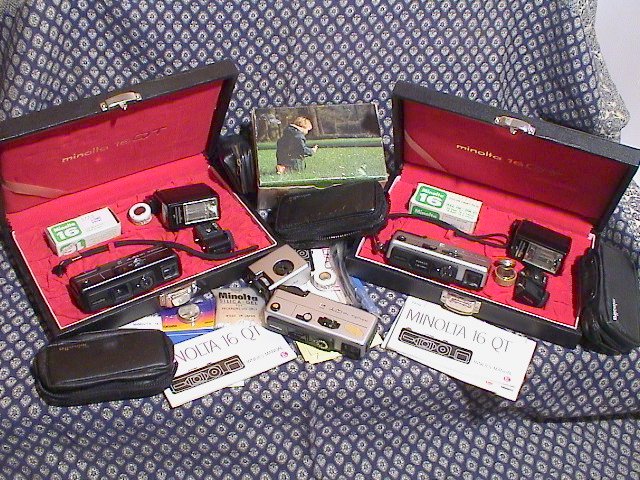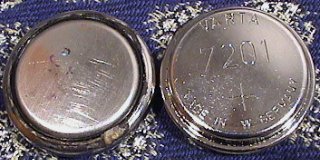
introduction | black cube | black kit | black (m/ft) | chrome cube | chrome kit | chrome (m/ft) | accessories
The last of the Minolta 16 series cameras was launched in 1972, just before the advent of the 110 format. This is the Minolta QT. More plastic than in previous models and similar in size to the MG-s. It shares the MG-s flash and cube units, spy-finder, the close up lenses and filters. Only the copy stand can not be used.

The QT also has a 23mm f3.5 lens with f-stops from f3.5 to f22. Only two shutter speeds, a fast 1/250th and 1/30th for dull light or flash. The QT is the only Minolta 16 camera with a focusing lens. Cameras with high serial numbers have a distance scale marked in feet and metres (after 196467 and before 208712 which was sold in a kit). Other cameras have a set of icons shown head, torsos, full body of a figure and mountains.
The meter is powered by a PX30 battery, huge for such a small camera. A button on the top activated the meter and the letters 'O' and 'K' light up for under and over exposure. A wheel adjusts the aperture. When the letters flash alternatively the correct aperture has been set. Film speeds from 50 to 400.
The Minolta QT was manufactured from 1972 to 1974 and was designed to meet the challenge of a making a simple to use pocket camera. With it's 12x17mm size it was pitched against the new Kodak 110 (13x17mm negative size) camera. Despite it's features and quality lens it could not compete with the new, cheaper 110 cameras and processing.Two colours were available: a black & chrome version, and an all black model.
The QT has a very similar body style to the earlier Minolta MG-s. It has the same 12x17mm image size and shares many of the MG-s' wide range of accessories. Filters: 1A, 80A, Yellow. Close-up Lenses: 80cm, 40cm. (the 25mm close-up lens of the MGS could be used, but since it blocked the viewfinder, it could only be used with exact manual measurements.) Spy finder, close-up measuring chains, wrist strap, attaché case, flash bulb adapter, flash cube adapter, electronic flash adapter.
Compared to the MG-s it gained and lost features. The shutter selection is 1/30th and 1/250th and the lens slower at f3.5 ranged to f22. The three elements in three groups focusing lens dispensed with a built in close up lens and has a good depth-of-field that is easy to establish. The focal distance set is visible in the viewfinder- far (33 feet), normal (11.5 feet), intermediate (6.5 feet) and close focusing (4 feet). There are no exposure readings but the 'OK' visible in the viewfinder is very simple to operate.
A little pressure on the 'OK' button can active the display and drain the battery. The case supplied with the QT has a 'cut out' shape to avoid this when the camera is carried. The camera only draws power from the batteries when BOTH the lens cover is open and silver button is pressed. The camera operates manually, without a battery.
The QT uses one PX30 battery or 2 PX-825. A CR2450 v3.0 battery can be used, but requires 4x1 pence coins as spacers to fit.

The case, like that of the MG-s, is a belt case and buttons down. However the case is a plastic/vinyl and does not age well. Whereas the MG-s case are often found in near new condition few QT cases are without faults in particularly the surface is frequently in a sticky state.
In 1972, the camera cost about £40 and the camera with bulb or cube flash cost about £46.
| Years of production | 1972-1974 |
| Lens | 23mm Rokkor |
| Aperture | f3.5-22 |
| Shutter Speeds | 1/30,1/250 switch |
| Focusing | Slide with 4 zone symbols adjusts focus from 1.2m to infinity with click stop or fixed focus operation at 3.5m (12ft) |
| Flash sync. | X contact M class AG-1 bulb 1/30s
electronic flash at 1/30 or 1/250s |
| Film Speed | ASA 25, 50, 100,200, 400. DIN 15, 18, 21, 24, 27 |
| Viewfinder | Bright-frame viewfinder with parallax correction, IC over and under exposure lamps, blinking correct-exposure "OK" signal, focus setting, and slow-shutter warning all visible while viewing |
| Film Advance | wheel type less than 120 degrees |
| Film Counter | Automatic resetting counter showing number of remaining frames |
| Exposure meter | Semi-automatic diaphragm control by CdS meter coupled to shutter EV 8.5 to EV 17 at ASA 100 |
| Negative Size | 12x17mm quarter-frame, 18 exposures |
| Finishes | chrome with black base black |
| Battery | one PX30 battery or 2 PX-825. A CR2450 v3.0 with pennies or washers to fill the space can be used |
| Supplied | chain and case presentation box with chain, flashcube unit |
| Manuals | English: icon scale QT112E-A1 m/ft scale QT310E-C2 |
| Dimensions | 109mm x 45 mm x 28mm ( 4 1/4" x 1 3/4" x 1 1/8") |
| Weight | 150g, 5.25oz |
| Filters | UV, Y48(Yellow), 1A, 80A in a single red or black plastic button clip case. |
| Auxiliary lenses | Close-up 40cm (1.3ft) with chain, 80cm (2.6ft) with chain in red or black plastic button clip cases. The 25cm (0.8ft) is only intended for use with the copy stand and so is not suitable for the QT. |
| Flash | MG-s flashgun in red or
black plastic button clip cases (15v Mallory M-504) MG-s cube gun in red or black plastic button clip cases (15v Mallory M-504) MG-s strobe adapter for electronic flash offers pc socket and hot shoe so a variety of electronic flash units can be used with the camera. A P electronic flash was included with the kit. |
| Spy finder | fits to the tripod socket and over the viewer |
| Standard Case | a small case case holds the camera, strobe adapter and P electronic flash. |
| Projector | Mini 16 |
| Enlarger | Minolta Enla-Unit 16 - Leica enlarging lens with 16mm carrier |
| Developing Tank | Dayload 16 |
| Lens Opening | 10m | 3.5m | 2m | 1.2m |
| F 3.5 | 4.69m - infinity | 2.51 - 5.78 | 1.64 - 2.57 | 1.06 - 1.38 |
| F 5.6 | 3.56m - infinity | 2.15 - 9.51 | 1.48 - 3.11 | 0.99 - 1.52 |
| F 8 | 2.79m - infinity | 1/85 - infinity | 1.33 - 4.08 | 0.93 - 1.71 |
| F 11 | 2.2m - infinity | 1.57 - infinity | 1.18 - 6.72 | 0.85 - 2.04 |
| F 16 | 1.63m - infinity | 1.26 - infinity | 1 - infinity | 0.76 - 3.01 |
| F 22 | 1.25m - infinity | 1.02 - infinity | 0.84 - infinity | 0.67 - 7.12 |
Last Updated on 26th May 2005